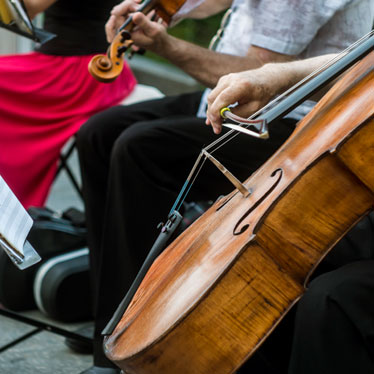5 Cello Pieces You Can Rock Right Now

The first, entry level songs you play on the cello are so exciting, and then they quickly become boring. Often based on nursery rhyme-like children’s songs, they only keep a beginning cellist inspired for so long. What is more inspiring than to play a classical piece that makes you sound – and feel – like you’re officially a cellist?
Whether you are a beginner cellist, or you’re the parent or loved one of a beginning cellist (interested in hearing something other than the cello basics), the following classical pieces are just the thing.
These well-loved cello classics are transcribed so their inherent beauty shines through, without the need to radiate advanced-level skills.
Allemande (German Dance WOO-42, No.1) by Ludwig Van Beethoven
Ludwig Van Beethoven is one of the most famous classical composers of all time. The ability to play a Beethoven piece helps to make cellists feel as if they have “arrived.” In 1796, he composed “Six German Dances,” for piano and violin. Widely popular, these dances have since been transcribed for all manner of instruments – including the cello.
This particular version of Beethoven’s Allemande is the first of the six dances and is transcribed for cello and piano. The piano accompaniment is very simple, making it a fun way to practice with a friend or sibling who plays piano. We’ve linked to it in the subtitle above so you can download it for free.
Interested in more free cello music? Visit our post, Free Music Resources for Musicians.
Gavotte by François-Joseph Gossec
In addition to being a fun and lively piece, François-Joseph Gossec’s, Gavotte provides beginning cellists the opportunity to practice their spiccato technique, where the bow bounces lightly on the string. This is often confused with staccato notes, so Gavotte can help you hone your ear for different bowing technique.
Click here to listen to a sample of Gavotte.
When you’re practicing, focus on playing the appoggiaturas on the beat to keep the piece in time – no lagging and no playing ahead of the accompaniment. This version is three pages long, which may be longer than the typical one- and two-page beginning cello pieces, so it helps to build physical and performance stamina.
Duo K 487, No. 1 by Wolfgang Amadeus Mozart
Do you enjoy practicing with friends? There’s no doubt that playing in an ensemble or chamber style can be more inspiring than playing solo. If you don’t have a cellist friend that lives nearby, consider using a lunch period, or staying after school, to learn Mozart’s Duo K 487, No. 1, originally written for two horns. Interestingly, Mozart did not provide any dynamics in this composition. While the piece, linked above, provides editorial suggestions, you and your partner have the opportunity to sense and feel how you believe the piece would best be expressed and then write those dynamics in for yourself.
Both cello parts appear on the same page, giving you a miniature glimpse of what it’s like to look at a symphonic score – where all of the parts are lined up on the same page for the conductor and concertmaster.
Trio Sonata in F Major, Op. 1, No. 1 (1: Grave) by Arcangelo Corelli
Here’s another opportunity to practice in an ensemble with your friends. The piece is transcribed for two violins and a cello. It’s the very first movement of the Sonata, titled Grave. Originally, Corelli scored this for two violins plus a continuo. During the baroque period, continuo stood for “an accompanying” instrument, which was typically a keyboard instrument, a violincello or a bass violi.
In this case, your cello will take a more traditional role, providing the fundamental bass and rhythm, so instrumental in supporting the featured instruments. However, we’re sure you’ll enjoy the very professional results when the three of you merge your talents to perform a very well-known and well-loved piece of classical music.
First Movement of Symphony No. 40 by Wolfgang Amadeus Mozart
Symphony No. 40 is one of the most famous of Mozart’s many symphonies (he reportedly wrote somewhere between 41 and 68 complete symphonic scores, the first of which was written when he was just eight years old!). Below, you can hear the Symphony’s first movement (and enjoy visual graphics as they animate the sounds you’re hearing). We’d be shocked if you’ve never heard this one before!
The version linked above is written for two cello parts, which means you can learn one – or both – and mix-and-match them with other eager cellists in your class or group of friends. We featured this piece in our article, Top 10 Classical Cello Compositions to Wow Your Friends, and recommend reviewing that list as well to develop your expanded beginning cellist classical repertoire.
The more you work on these classical compositions transcribed for beginners, the easier it will be as you work your way into more intermediate and advanced compositions.
Sponsored by Thomastik-Infeld


